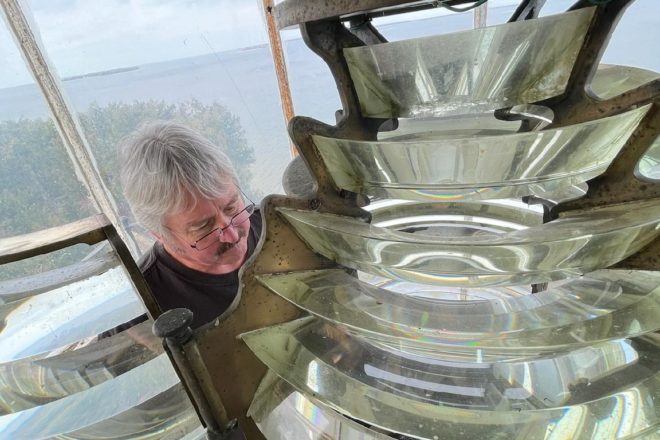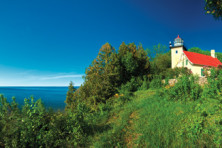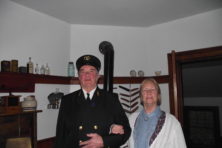Eagle Bluff Lighthouse Restoration Starts at the Top
- Share
- Tweet
- Pin
- Share

Lampist takes measurements to make parts for Fresnel lens
Restoration work kicked off last week at the Eagle Bluff Lighthouse in Peninsula State Park, starting at the top.
Door County Historical Society leaders called in one of the only four of five lampists in the nation to repair the Fresnel lens.
The commute to Door County was shorter than most for Kurt Fosburg, a Marquette, Michigan resident, and the Superior Lighthouse Service owner. Fosburg has repaired Fresnel lenses as far west as Hawaii and as far east as Bermuda, and as nearby as Plum Island and Kewaunee. The Coast Guard-certified craftsman also builds replica Fresnel lenses for collectors.
Eagle Bluff volunteer engineer Chuck Baum said repair work in the lighthouse this spring and summer will help correct condensation, leaks, and poor ventilation in the tower, as well as in the basement in the keeper’s house. Crews need to animal-proof and reopen a ball vent at the top of the lighthouse and to remake a half dozen draft vents in the side of the lantern room, Baum said.

When it rains, the iron circular stairway gets wet, and moisture causes problems for interior walls in the tower and house. Moisture combined with daytime sun and heat have speeded up deterioration of the brass frame and caulk-like litharge that holds the prisms of the lighthouse’s Fresnel lens.
Baum and Fosburg carried the Coast Guard-owned lens down from the lantern room and crated it until August, when Fosburg can reinstall it. To repair the interior walls and repaint the interior of the lantern room, contractors will use sandblasting techniques. The Fresnel lens has to come out during that work, and Fosburg will machine missing parts, such as a hinge thumbscrew. He also will replicate three prisms at the top of the lens and one on the bottom, in acrylic – a material that never could have been used when lard and later kerosene were used to fuel the light.

Kurt Fosburg takes measurements to make parts to repair the lens. Photo by Craig Sterrett. 
(From left) Chuck Baum, DCHS volunteer and structures engineer, watches Kurt Fosburg inspecting the Fresnel lens. Photo by Craig Sterrett.
Baum said improved ventilation in the tower, tower basement and keeper’s house basement should prevent future water damage throughout the building.
Now 156 years old, the lighthouse has been owned by the Wisconsin Department of Natural Resources and cared for by Door County Historical Society (DCHS) volunteers since 1960. Automated in 1926, the lighthouse was not tended to closely between 1940 and 1960, said Amy Frank, DCHS executive director.
Frank said the Society contracted with Wisconsin Public Service to once again provide electrical service to the keeper’s house and tower – for interior lighting, not the lighthouse lantern room. A toaster-sized, solar-powered, Coast Guard-installed light mounted on the exterior of the tower contains batteries and can be seen seven miles away from the lighthouse, Baum said. The Fresnel lens, when in use more than a century ago, shone 17 miles to Cedar River, Michigan, he said.

DCHS plans to accurately restore the lighthouse interior and paint schemes to the time period when the Duclon family tended the facility (1883-1918). The site previously included a summer kitchen to the east and a small barn. DCHS is awaiting state Natural Resources Board approval May 22 to build those structures, and upon their completion, the gift shop can move out of the keeper’s house.
The oil house about 30 yards from the lighthouse was built after 1868. Lighthouse volunteer Ed Miller said lard originally fueled the lantern. The fuel was stored in the lighthouse basement. He said frequent lightning strikes to the lightning rod sent electricity down the lighthouse walls to the basement. When the lighthouse service switched to kerosene, storing it at the bottom of the tower became an explosion hazard.



